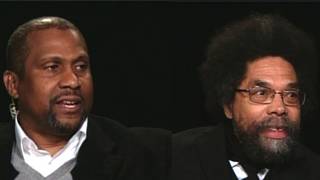
Guests
- Heidi Shierholzlabor economist at Economic Policy Institute in Washington, D.C. She is also a member of the board of directors of the D.C. Employment Justice Center.
A new U.S. Census Bureau report reveals the number of people living in poverty last year surged to 46.2 million—one in six Americans—the highest number since the Bureau began tracking such data more than 50 years ago. According to the report, blacks and Hispanics together accounted for 54 percent of the poor, with whites at 9.9 percent and Asians at 12.1 percent. Children under 18 suffered the highest poverty rate. Meanwhile, the number of Americans with employer-provided health insurance has also continued to decline, and the ranks of the uninsured now hovers just below the 50 million mark, the most in more than two decades. Analysts say the numbers would have been worse if not for government assistance programs, including extended unemployment compensation, stimulus spending, Obama’s health reforms, and Social Security. We speak with Heidi Shierholz, labor economist at the Economic Policy Institute. [includes rush transcript]
Transcript
NERMEEN SHAIKH: We turn now to look at the devastating financial reality now facing many Americans. A new report from the U.S. Census Bureau reveals the number of people living in poverty last year surged to 46.2 million. That’s one in six Americans, the highest number since the Bureau began tracking such data more than 50 years ago. The report reveals that in 2010, the U.S. poverty rate rose for a third consecutive year to hit 15.1 percent. Overall, children under 18 suffer the highest poverty rate. The report also showed that blacks and Hispanics together accounted for 54 percent of the poor, with whites at 9.9 percent and Asians at 12.1 percent.
AMY GOODMAN: Meanwhile, the number of Americans with employer-provided health insurance has also continued to decline. The Census Bureau reports the ranks of the uninsured hovered just below the 50 million mark, the most in more than two decades. Analysts say numbers would have been far worse if not for government assistance programs, including extended unemployment compensation, stimulus spending, Obama’s health reforms, and Social Security. The Census report coincides with Obama’s push for a close to $450 billion job creation package.
For more, we turn to Heidi Shierholz in Washington, D.C., labor economist at the Economic Policy Institute, member of the board of directors of the D.C. Employment Justice Center.
Heidi, welcome to Democracy Now! Talk about these figures.
HEIDI SHIERHOLZ: Thank you for having me.
AMY GOODMAN: One in six Americans are poor.
HEIDI SHIERHOLZ: Yeah, you know, when I look at a report like this, what it tells me is that it shows the real human consequences of the economic downturn that we’ve seen. One in six Americans are poor. One in five kids are living in poverty. Here’s another stat that I think is just stunning: one in 10 kids are living in deep poverty. So, deep poverty is defined as half of the poverty threshold. And just to give you an idea of where that is, it’s $11,000 for a family of four. So, one in 10 kids in this country is living in a family that makes—if they have a family of four, that makes less than $11,000. So it is just a really severe problem.
It shows that the job loss that we have seen over the last three years, it permeates out, it hits everyone. And the other thing this report shows is that when I say it hits everyone, it wasn’t just people at the bottom that have taken big hits. We saw declines across the income distribution. If you look at the median income, the middle family, the sort of typical family, they also saw substantial declines in income. Something as big and long-lasting as the Great Recession, it’s just—the feelers of that are just really still hitting our population.
NERMEEN SHAIKH: Heidi, what would you say the main causes of this are?
HEIDI SHIERHOLZ: Yeah, it’s a good question, and at this point, when you look at the changes over the last three years, it’s crystal clear the main causes are job loss due to the Great Recession. So, over the—at this point, taking into account both the jobs we’ve lost since the start of the recession plus the jobs that we should have gained just to keep up with natural—the natural expansion of the working-age population, the jobs deficit our country is in is 11 million. Families take hits because of lost jobs and unemployment. They also are taking income hits due to reductions in hours and wage cuts. The persistent high unemployment keeps wage growth really low. So all of those things, the weakness in the labor market, translates into losses for families.
And then, obviously, when you’re talking about the health insurance numbers, the health insurance coverage numbers, which also came out, when you have people losing jobs when they have employer-sponsored health insurance, that goes out the window. So that also is directly related to the loss of jobs.
One thing I think is important to note, this report was about 2010. We actually were in a recovery, in an official recovery in 2010. But the losses that we saw through 2009 were so severe, and the very modest growth that we saw in 2010 wasn’t enough to make up for that. And so, the labor market actually deteriorated between 2009 and 2010, which is why we see these big hits in the 2010 numbers that just came out.
AMY GOODMAN: Talk about the racial divide, Heidi Shierholz. One in six people are poor, more than half of them black and Latino.
HEIDI SHIERHOLZ: Yeah. So I think that’s a really important thing that comes through in these numbers, that racial and ethnic minorities started out with higher levels of poverty, started out with lower levels of typical income, and they’ve gotten hit harder by the Great Recession. They’ve seen bigger increases in poverty, bigger declines in income for typical families. And you see that is also very related to labor market outcomes. Racial and ethnic minorities have seen much larger increases in unemployment over the last three years. So it all fits together in this really clear story of, the weakness in the labor market is at the heart of all this. The key thing we need to do right now is get jobs back.
NERMEEN SHAIKH: Heidi, can you say a little about how poverty is defined in this study? What constitutes poverty?
HEIDI SHIERHOLZ: Yeah, that’s a really good point, and it’s controversial. So the poverty threshold is, by anyone’s measure, extremely low. So, to give you an idea, for a family of four, the poverty threshold is just over $22,000. So anyone thinking about trying to live on $22,000 with a family of four will immediately realize that that’s not a really reasonable cutoff for material deprivation. And poverty researchers actually use, in many cases, twice the poverty line to have a more reasonable idea of what the—a sort of cutoff for material deprivation, for, you know, below this—above this number, you have what you need to make ends meet—
AMY GOODMAN: Five seconds.
HEIDI SHIERHOLZ: Below this, you don’t. So there really is—by alternative measures of poverty that take those things into account, the poverty rates are even higher than the numbers that we saw yesterday.
AMY GOODMAN: Well, Heidi Shierholz, we want to thank you so much for being with us, with the Economic Policy Institute in Washington, D.C. Thanks so much. Go to our post-9/11 decade timeline at democracynow.org.











Media Options